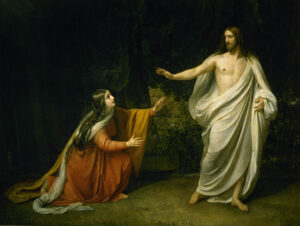In some ways it would be difficult to imagine a greater contrast than that which exists between the manger in which the infant Christ was laid and the soaring splendour of a Gothic cathedral. The former is literally a feeding trough for animals, while the latter is one of the most beautiful and impressive achievements of human design, engineering, and construction. A manger could be built in very little time out of simple resources, whereas building a Gothic cathedral could require hundreds of labourers working for hundreds of years.
Yet carefully considered, both the manger and a Gothic cathedral can serve as paradigmatic sacred spaces. The manger speaks of humility and weakness, but a cathedral constructed in the Gothic style speaks of heavenly glory and power. In the incarnation, humility and glory, power and weakness came together in the person of our Lord.
The Incarnational Theology of a Gothic Cathedral
The shift away from Romanesque to Gothic architecture occurred for a variety of sociological, theological, and technical reasons. Those who designed Gothic cathedrals wanted to create sacred spaces that transported worshipers to heaven by bringing heaven down to earth. Architecture was seen as an artistic medium that had numerous diverse functions—it was the discipline that could bring together engineering and art, construction and philosophy, building and theology.
A cathedral that was built in the Gothic style was designed to embody the celestial harmony and beauty of heaven itself. It was to be, quite literally, a reflection of God’s home in glory, and a fitting place for him to dwell on earth. Following Augustine, medieval theologians believed that the physical world represented the glory of God and pointed back to him, but given our sin, people needed divine illumination in their minds and hearts to see spiritual truths, just as they needed physical light to see clearly in the material world. The divine gift of light was crucial. God’s light was necessary for epistemology, metaphysics, ethics, and religion.
Given the importance of light both physically and spiritually, it is not surprising that light functions in a variety of ways in Scripture. God is light. The first time God speaks, he says “Let there be light.” Light is a biblical metaphor for purity. Jesus Christ is the light of the world.
At Christmas, we remember how the divine Light became a man. Christ was light incarnate. Gothic cathedrals were designed as sacred places where heaven met earth, where God met humanity. The cathedrals were built to showcase the light of heaven here in this world, being, in part, vessels for the incarnation of light. The heart of the worshiper was to be brought up to the light of heaven, and the light of heaven was brought down to the worshiper. The incarnate Christ—the true light—came into the world to reveal to us heaven’s light.
Today, as much as we recognize that music and the visual arts can help us appreciate the incarnate Lord, we also need to understand that architecture and the flow of sacred spaces can also communicate theological truths. So how did the design and architecture of Gothic cathedrals enable them to reveal God’s light in ways that had not been possible before?
Architecture in the Service of the Divine Light
Romanesque architecture was typified by massive walls, small windows, and a sculpted enclosure. The painted interiors strove to deny the mass of the structure and create an environment that would produce an illusion of the image of heaven on earth, but could never come close to the dematerialization with light that the Gothic period achieved. Light was necessary for the worthy glorification of God.
The east end of the cathedral was typically where the altar was located, and the building was entered through the west door. The altar and choir in front of it were separated from the nave—the area occupied by the congregation—by the transept and crossing. The choir and altar were considered the heavenly realm. When one stood at the crossing of a Gothic cathedral, it was to be as if one stood at the gates of heaven, drawn to the lightness of the choir. The ambition to bring as much light as possible into the choir and altar resulted in the elimination of a significant proportion of structural mass in order to make the windows as large as possible.
The Gothic period was a logical progression in the pursuit of architects to create openings in the walls without compromising the structural integrity of buildings. The revolutionary method developed to achieve this reduction in mass was the pointed arch and corresponding ribbed vault. With rounded arches, the geometry was extremely restrictive. The pointed arch allowed for unprecedented freedom in shaping the interior spaces. Ribbed vaulting allowed for larger windows and more flowing unity to the spaces. Particularly around the altar, there was a desire to have minimal structure so that light could penetrate to it, with the choir becoming the crown of light at the head of the church and the crown of heavenly windows.
This solution led to all the other developments in Gothic architecture, including flying buttresses and the ground plan of the piers. The pointed arch could also carry up to three times the weight of the rounded arch, allowing walls to be significantly higher. The pressure of the outward thrust from the vaults had to be proportioned to the piers in the outer walls.
However, the introduction of light was still the governing factor, so the flying buttress was developed to transfer loads away from the mass of the building. This made it possible to build taller, and it also allowed for the development of clerestory windows, which was one of the most important improvements in lighting the interior. The interior structure supporting these upper walls could be minimized with the load being taken directly outward by the flying buttresses. The use of stained glass as the medium for the heavenly light to pass through transformed the everyday world into the beauty and transcendence of heaven, and transformed the minds that perceived it from dullness to illumination.
Thus the eye (and the mind) was drawn upwards into heavenly light as the structure of the material world dissipated.
Conclusion
Despite the stark contrast between the scene of Jesus’ birth and the magnificence of a Gothic cathedral, the latter does serve as a theological edifice that resonates with a part of the meaning of the incarnation. Architecture—like all human crafts—can be undertaken to the glory of God. The Lord is the architect of the universe, fashioning a world to reveal his light. John wrote of Jesus, “The light shines in the darkness” (John 1:5a), and this was made possible in the incarnation.
Gothic cathedrals stand as monuments to human ingenuity, but even more so they stand as monuments to God’s light, power, and glory, both in heaven and on earth. These are themes that are worthy of meditation all year round but can be seen to have special significance at Christmas time.
























